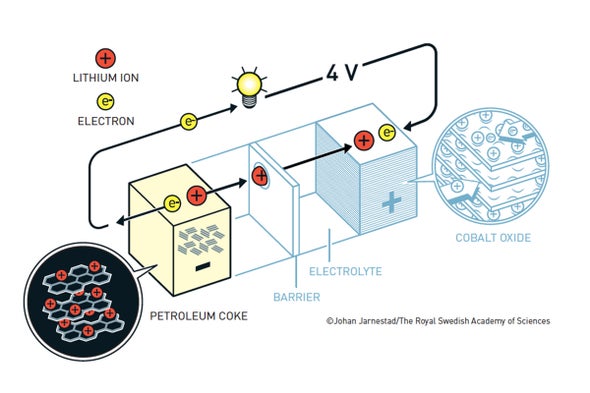(单词翻译:单击)
听力文本
This is Scientific American's 60-second Science, I'm Steve Mirsky.
"This year's prize is about a rechargeable world. The Royal Swedish Academy of Sciences has today decided to award the 2019 Nobel Prize in Chemistry jointly to John B. Goodenough, M. Stanley Whittingham and Akira Yoshino for the development of lithium-ion batteries."
Göran Hansson, secretary-general of the academy, earlier today.
"John B. Goodenough was born in Jena, Germany, in 1922. He obtained his Ph.D. at the University of Chicago, and he's currently affiliated with the University of Texas at Austin in the United States. Being born in 1922, Dr. Goodenough is the oldest Nobel laureate ever awarded the prize. Dr. (Arthur) Ashkin, last year's Physics laureate, is actually a couple of months younger."
"M. Stanley Whittingham was born in 1941 in Nottingham in the United Kingdom. He got his Ph.D. from Oxford University in the U.K., and he is today at Binghamton University of the State University of New York system in the United States. Akira Yoshino was born in 1948 in Suita in Japan. He is professor at Meijo University in Nagoya and he's also affiliated with the Asahi Kasei Corporation in Tokyo in Japan. And now I'd like to ask Sara Snogerup Linse of the Nobel Committee for Chemistry to make some remarks about the prize."

"This year's Nobel Prize in Chemistry rewards the development of lithium-ion batteries. We have gained access to a technical revolution. The laureates developed lightweight batteries of high enough potential to be useful in many applications: truly portable electronics, mobile phones, pacemakers—but also long-distance electric cars. The ability to store energy from renewable resources—the sun, the wind—opens up for sustainable energy consumption."
For an in-depth listen about the 2019 Nobel Prize in Chemistry, look for the Scientific American Science Talk podcast later today.
For Scientific American's 60-second Science. I'm Steve Mirsky.
参考译文
这里是科学美国人——60秒科学系列,我是史蒂夫·米尔斯基。
“今年的诺贝尔化学奖涉及可充电领域。瑞典皇家科学院今天决定将2019年诺贝尔化学奖共同授予约翰·班宁斯特·古迪纳夫、斯坦利·惠廷厄姆和吉野彰,以表彰他们在锂离子电池研发领域作出的贡献。”
今天早些时候,瑞典皇家科学院秘书长戈兰·汉森宣布了获奖者。
“约翰·班宁斯特·古迪纳夫1922年出生于德国耶拿。他在芝加哥大学获得博士学位,目前在美国得克萨斯大学奥斯汀分校工作。出生于1922年的古迪纳夫博士是诺贝尔奖历史上年龄最大的获奖者。去年的诺贝尔物理学奖得主阿瑟·阿什金博士要比他小几个月。”
“斯坦利·惠廷厄姆1941年出生于英国诺丁汉。他在英国牛津大学获得博士学位,现在就任于美国纽约州立大学宾汉姆顿分校。吉野彰1948年出生于日本吹田。他是名古屋名城大学的教授,同时就职于旭化成工业株式会社。下面我想请诺贝尔化学委员会的萨拉·斯诺格鲁普·林斯简要介绍一下该奖项。”
“今年的诺贝尔化学奖奖励的是锂离子电池研发。我们已进入一场技术革命。获奖者研发出了足够高电能的轻便电池,可应用于多个领域:真正的便携式电子产品、移动电话、起搏器,以及长距离电动汽车。从太阳和风等可再生资源中储存能量的能力,开启了可持续能源消费。”
若想深入了解2019年诺贝尔化学奖,请收听今天晚些时候播出的《科学美国人》“科学对话”播客。
谢谢大家收听科学美国人——60秒科学。我是史蒂夫·米尔斯基。
译文为可可英语翻译,未经授权请勿转载!
重点讲解
重点讲解:
1. be affiliated with 与…有正式关系的,为…工作的;
A display of a dentist's office inside a Jenin museum depicting daily Palestinian life is adjusted by a worker affiliated with the museum.
在以色列博物馆内展示着一间牙医诊所描述日常巴勒斯坦人的生活,博物馆的工作人员在做一些修整。
2. a couple of 两个;几个;
He had lent the bungalow to the Conrads for a couple of weeks.
他把那间平房借给康拉德一家住了两三个星期。
3. would like to do sth. (礼貌地提议或邀请)想要;
We would like to thank them for their patience and understanding.
我们要感谢他们的耐心和理解。
4. open up (使)(机会、可能性等)出现;(使)产生;
It was also felt that the collapse of the system opened up new possibilities.
人们也认为这一制度的崩溃带来了各种新的可能性。


